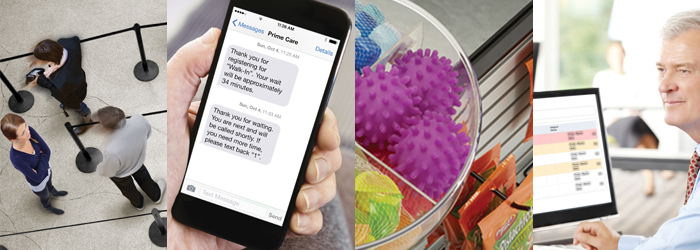David Aaker, Professor Emeritus of Marketing Strategy at the Haas School of Business and author of Brand Relevance: Making Competitors Irrelevant, wrote a nice piece for RetailCustomerExperience.com recently where he outlined eight characteristics of successful retail concepts. Aaker looked at common characteristics shared among brands like L.L. Bean, REI, IKEA, Apple, Whole Foods, and other distinctive retailers. We looked at the resulting eight guidelines and how they might apply to an important piece of retail business: the queue. Knowing that the queue (waiting line) is a place where business is won and lost, and where lasting impressions are formed, we think it makes good sense to look at your queue as a business-within-your-business and formulate a smart strategy. So, let's look at how Aaker's findings might apply to your queue:
1. Have a clear vision

Successful retailers have a clear vision of who they are, who they serve, and how their brand connects with customers. Who are your customers? Are they wealthy urbanites, frugal stay-at-home moms, GenYers, outdoor enthusiasts? What’s important to them when it comes to the queuing experience? Do they just want to get in and out as if they’re in a convenience store or is waiting part of the experience as if they’re buying cronuts? Think about how you want your waiting line to be perceived and what the customers’ experience of waiting in your queue says about your company. Knowing what they expect from a queue – or what they are unwilling to tolerate – can help you develop a clear vision of how you want your waiting line to operate.
2. Evolve the offering
You’ve probably heard the mantra that if you’re standing still, you’re falling behind. Part of being a successful retailer is having the ability to evolve over time. The same can be said about your waiting line. The queue formation you started with in the early days might not continue to work as you grow. Likewise, as your customers’ expectations grow and change, they’ll be looking for you to keep pace with their demands.
3. Execute
Successful retailers don’t just talk about their vision. They execute on it. Take the steps necessary to create a queuing process that reflects how you want your customers to see you. Be relentless in pursuing the ideas, technologies, and practices that will allow you to reach your goals.
4. Develop a strong culture and set of values
It’s easy for upper management to sit in a room and formulate their ideas of how the service and offerings of their company should be portrayed. It’s another to build a culture around the values that drive this vision forward. Trader Joe’s is adored by customers for its product selection and pricing. But you might be surprised to find that the number one reason shoppers love Trader Joe’s is for its speedy checkouts. You see, Trader Joe’s has engrained in its staff and management the idea that there should always be adequate staffing available to open up new lines at the drop of a hat. This service is part of the culture and values of the company.
5. Deliver emotional benefits

Top retailers embrace the idea that consumers use their left brain and their right brain to make buying decisions and establish brand preference. When we can tap into both the logical side of a purchase ($200 jeans) and the emotional side (designer jeans that fit me perfectly and reflect how I want to be seen by others), we are more likely to get the sale. Relating this to queuing, during the post-World War II building boom as high rises began to pop up on city skylines, an unexpected consequence occurred. Building owners were inundated with complaints from busy workers, who were trying to get to and from their offices, about the length of time spent waiting for the elevator. It was at this time when queuing theorists stopped asking, “How do we reduce the wait?” and started asking, “How do we reduce the complaints about the waits?” The answer revealed itself in the installation of floor to ceiling mirrors that kept people happily engaged in looking at themselves (and slyly at each other). Complaints dropped to nearly nothing. The point is, when it comes to queuing it’s important to think both about the actual time spent waiting and the perception of the time spent waiting. If you can take customers’ minds off the wait, the time spent waiting will feel a lot shorter.
6. Address an unmet need

Great businesses form to meet an unmet need. Whole Foods recognized a need to provide organic and natural foods to consumers who were increasingly looking for healthier choices. HI-CHEW candy has become an international phenomenon with a product that acts like gum but dissolves like candy, addressing the long-standing Japanese taboo against taking food out of one’s mouth. Starbucks CEO, Howard Schultz saw a need to connect people by bringing an Italian coffeehouse tradition to the United States. When it comes to your waiting line, an unmet need might be helping your customers avoid standing in line altogether. Virtual queuing systems can address this need well. But look around—find out what your customers are doing or would RATHER be doing while standing in your line and find a way to fill those needs.
7. Scale
Retailers need to be able to scale their offerings to meet customer demand and remain profitable as business grows or contracts. In the same way, your checkout line should be structured in a way that allows the line and staff to accommodate more people in busy times and fewer people in slow times. Draw your line in the sand and establish your “maximum allowable wait time” for customers and do your best to monitor wait times and react quickly when the line becomes unacceptably long.
8. Integrate social and environmental programs
Today’s consumers are looking for companies to give back to their communities and to protect environmental resources. If these programs are part of your company mission, don’t be afraid to talk about it. For example, you could take the opportunity to inform your customers about a new social initiative or communicate the success of a recent environmental or social program through digital signage in the checkout area. Or maybe your checkout line could be filled with only environmentally-sensitive products. Find an authentic way to bring these programs to the captive audience in your queue. The waiting line is an important part of any retail establishment. It is one part of the shopping experience that can make or break a long-term customer relationship. As such, it makes sense to look closely at the checkout area both as a separate business unit as well as an integral part of the entire retail experience. How will you apply these lessons to your checkout line?













